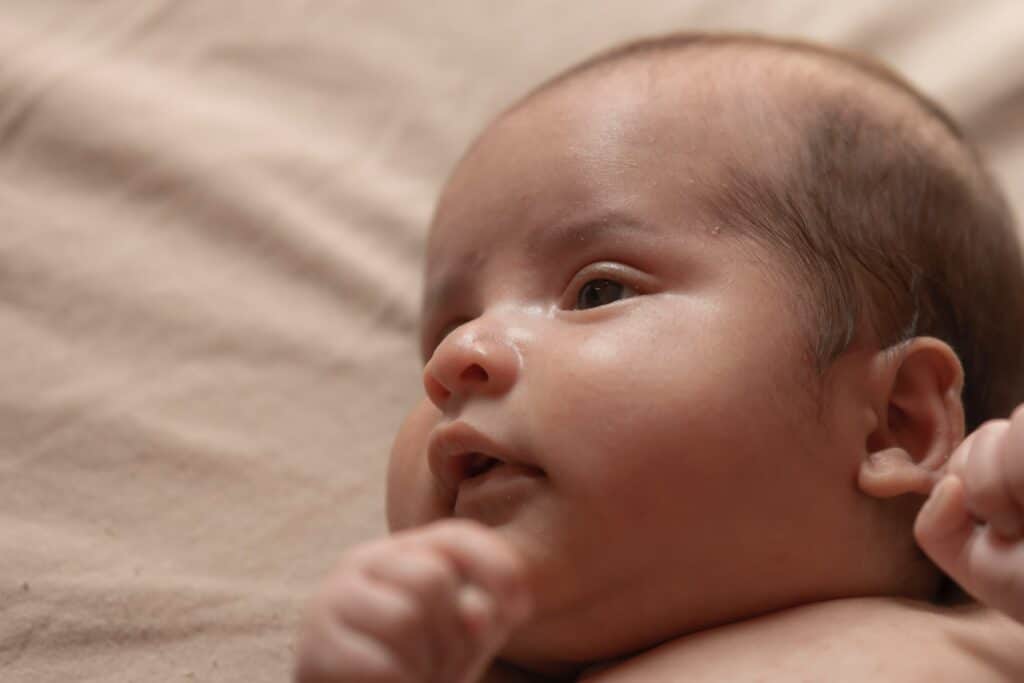Babies are known to exhibit various behaviors during their early developmental stages. One of these behaviors is tilting their head to one side or shoulder. While this behavior may seem harmless, it can be a cause for concern for parents. This article aims to provide an overview of baby tilting head to shoulder teething, including its causes, effects, and possible treatments.
Understanding Baby Tilting Head Behavior
Tilting the head to one side or shoulder is a common behavior among babies. It is often seen when they are trying to get a better view of something or when they are feeling uncomfortable. However, when this behavior becomes persistent, it may indicate an underlying condition.
Teething and Its Effects
Teething is a natural process that occurs when a baby’s teeth start to emerge. It can cause discomfort and pain, which may lead to changes in behavior. One of these changes is tilting the head to one side or shoulder. This behavior may be a way for the baby to alleviate the discomfort caused by teething. However, it is important to note that not all babies exhibit this behavior when teething.
Key Takeaways
- Baby tilting head to shoulder is a common behavior among babies.
- Teething can cause discomfort and pain, which may lead to changes in behavior.
- Persistent head tilting may indicate an underlying condition and requires pediatric consultation.
Understanding Baby Tilting Head Behavior
Babies are known to engage in various behaviors that may seem unusual to adults. One of these behaviors is tilting their head to one side or shoulder. This behavior can be observed in newborn babies, infants, and toddlers. While it is normal for babies to tilt their head occasionally, frequent tilting of the head may indicate an underlying condition that requires medical attention.
Possible Causes of Baby Tilting Head Behavior
There are several reasons why a baby may tilt their head to one side or shoulder. Some of these reasons include:
- Teething: When babies are teething, they may tilt their head to one side to relieve the discomfort caused by the teething process. This behavior is often accompanied by other teething symptoms such as drooling, irritability, and biting.
- Torticollis: This is a condition that causes the muscles on one side of the neck to become tight or shortened, resulting in the baby tilting their head to one side. Torticollis can be congenital or acquired and may require physical therapy to correct.
- Vision problems: Babies with vision problems may tilt their head to one side to see things better. This behavior is often accompanied by other symptoms such as squinting, rubbing eyes, and excessive tearing.
- Ear infections: Ear infections can cause pain and discomfort in the ear, which may lead to the baby tilting their head to one side to relieve the pain.
When to Seek Medical Attention
Parents should seek medical attention if their baby tilts their head excessively or if the behavior is accompanied by other symptoms such as fever, vomiting, or lethargy. A pediatrician can perform a physical examination to determine the underlying cause of the behavior and recommend appropriate treatment.
In conclusion, baby tilting head behavior is a common occurrence that may be caused by various factors. While occasional tilting of the head is normal, parents should seek medical attention if the behavior is excessive or accompanied by other symptoms.
Teething and Its Effects
Teething is a natural process that occurs when a baby’s teeth begin to emerge from their gums. It usually starts around the age of 6 months, but it can happen earlier or later. During this time, the baby’s gums may become swollen and tender, which can cause discomfort and pain.
One of the most common symptoms of teething is a low-grade fever. This is a normal response to the inflammation caused by the emerging teeth. The fever is usually mild and doesn’t require any treatment. However, if the fever is high or accompanied by other symptoms, such as vomiting or diarrhea, it’s important to contact a pediatrician.
Teething can also cause irritability and crying in babies. This is because the discomfort and pain associated with teething can make them feel uncomfortable and unhappy. It’s important to provide comfort and support to the baby during this time, such as by offering a pacifier or teething toy.
In some cases, teething can also cause reflux in babies. This is because the increased drooling associated with teething can cause them to swallow more air, which can lead to reflux. If the baby is experiencing reflux, it’s important to talk to a pediatrician to determine the best course of treatment.
Overall, teething is a natural process that can cause discomfort and pain in babies. By providing comfort and support, parents can help their babies get through this phase with as little discomfort as possible.
Role of Ear Infections
Ear infections can be a common cause of a baby tilting their head to their shoulder while teething. This is because the pain from the infection can cause discomfort in the neck and jaw area, leading to the baby tilting their head to one side to alleviate the pain.
Ear infections occur when the middle ear becomes inflamed and fills with fluid, which can cause pain, fever, and discharge from the ear. If left untreated, ear infections can lead to hearing loss and other complications.
Antibiotics are often prescribed to treat ear infections, and it is important to follow the prescribed course of treatment to ensure the infection is fully cleared. In some cases, surgery may be necessary to treat chronic or severe ear infections.
If a baby is experiencing ear pain or discomfort, it is important to seek medical attention to determine the cause and appropriate treatment. In some cases, ear infections may be a recurring issue and require ongoing management.
Overall, understanding the role of ear infections in a baby tilting their head to their shoulder while teething can help parents and caregivers identify and address potential health concerns in a timely manner.
Torticollis: A Common Cause
Torticollis, also known as wryneck, is a condition where the head is tilted to one side while the chin is pointed to the other. This condition can occur due to a variety of reasons, including neck trauma, congenital muscular torticollis, or acquired torticollis.
Congenital muscular torticollis is the most common cause of torticollis in infants. This condition occurs when the sternocleidomastoid muscle, located on one side of the neck, is shortened or tightened. This can lead to a head tilt and limited neck motion.
Acquired torticollis can occur due to a variety of reasons, including neck trauma, infections, or tumors. Ocular torticollis can also occur due to a problem with the eyes or vision.
Infant torticollis can lead to difficulties with breastfeeding, as the infant may have difficulty turning their head to one side. It can also lead to developmental delays if left untreated.
Treatment for torticollis depends on the underlying cause. For infant torticollis, physical therapy and stretching exercises can be effective in improving neck motion and reducing head tilt. In some cases, surgery may be necessary to correct congenital torticollis or other underlying conditions.
In rare cases, torticollis can be a symptom of Klippel-Feil syndrome, a rare genetic disorder that affects the development of the spine.
Overall, torticollis is a common condition that can occur due to a variety of reasons. It is important to seek medical attention if you or your child experiences symptoms of torticollis, as early intervention can lead to better outcomes.
Physical Therapy and Exercises
Physical therapy can be an effective way to help babies with tilting their head to the shoulder while teething. A physical therapist can provide guidance on exercises that can help strengthen the neck muscles and improve head control.
Simple exercises, such as gentle stretches and tummy time, can be helpful in encouraging babies to move their head and neck in different directions. A physical therapist can also provide guidance on exercises that can be done at home to help with head tilting.
During physical therapy sessions, a therapist may use various techniques to help improve head control, such as gentle massage or range-of-motion exercises. The therapist may also use toys or other items to encourage the baby to move their head in different directions.
It is important to note that physical therapy should only be done under the guidance of a licensed therapist. Parents should not attempt to perform physical therapy exercises on their own without proper training and guidance.
In summary, physical therapy and exercises can be helpful in improving head control and reducing tilting of the head to the shoulder while teething. A licensed physical therapist can provide guidance on exercises that can be done at home and during therapy sessions to help improve head control.
Other Possible Conditions
While teething is a common cause of a baby tilting their head to their shoulder, there are other possible conditions that could be causing this behavior.
One possible condition is strabismus, which is a misalignment of the eyes. This can cause the baby to tilt their head in an attempt to align their eyes and improve their vision. Another possible cause is an eye injury, which can cause discomfort and pain in the eye and lead to head tilting.
Inherited nervous problems, such as cerebral palsy, can also cause a baby to tilt their head to one side. This is due to muscle weakness or stiffness and can affect the baby’s ability to control their head movements.
Other conditions, such as torticollis, can also cause head tilting. Torticollis is a condition where the muscles in the neck become tight or shortened, causing the baby’s head to tilt to one side. This can be treated with physical therapy and stretching exercises.
Finally, swelling in the neck can also cause head tilting. This can be due to lymph node enlargement or other conditions, and should be evaluated by a healthcare professional.
It is important to note that while these conditions can cause head tilting, they are not always the cause. If a baby is consistently tilting their head to one side, it is important to consult with a healthcare professional to determine the underlying cause and appropriate treatment.
Importance of Pediatric Consultation
When a baby starts tilting their head to one side and shoulder, it could be a sign of teething. However, it is crucial for parents to seek a pediatrician’s consultation to rule out any other underlying causes.
Pediatricians are trained to diagnose and treat various conditions in infants and young children. They can perform a thorough examination to determine the cause of the head tilting and recommend appropriate treatment.
In addition to diagnosis and treatment, pediatricians also play a crucial role in monitoring a child’s development. They can track a child’s growth and identify any delays or abnormalities early on, which can lead to better outcomes.
Communication is also essential in pediatric consultations. Parents should be open and honest with their pediatrician about any concerns or questions they may have. The pediatrician can provide guidance and support, and work together with the family to ensure the child’s health and well-being.
In some cases, news of a diagnosis can be overwhelming for families. However, pediatricians can provide resources and referrals to support services that can help families cope and manage the condition.
In summary, consulting with a pediatrician is essential when a baby tilts their head to one side and shoulder. Pediatricians can provide diagnosis, treatment, monitor development, and offer support for families. Parents should communicate openly with their pediatrician and seek their guidance and expertise.
Pregnancy and Birth Factors
There are several pregnancy and birth factors that can contribute to a baby tilting their head to their shoulder while teething. These factors can include:
- Position in the uterus: If a baby was in a breech position in the uterus, it may have put extra pressure on their neck muscles, which could cause them to tilt their head to one side.
- Birth trauma: If a baby experienced trauma during birth, such as a difficult delivery or use of forceps, it could cause tension in their neck muscles, leading to head tilting.
- Neck muscle weakness: If a baby’s neck muscles are weak, it can cause them to tilt their head to one side, especially when teething.
It’s important to note that while these factors can contribute to head tilting, not all babies who experience them will tilt their head. Additionally, head tilting can also be a normal part of development and may not always be a cause for concern.
Parents should monitor their baby’s head tilting and consult with their pediatrician if they have any concerns or notice any other developmental delays.
Related posts:
Frequently Asked Questions
What causes a baby to tilt their head to one side?
There can be a number of reasons why a baby may tilt their head to one side. It could be due to a muscle weakness or tightness in the neck, or it could be a sign of torticollis, a condition where the muscles in the neck become tight and cause the head to tilt to one side.
Is it normal for a baby to tilt their head to their shoulder while teething?
It is not uncommon for babies to tilt their heads to one side or the other while teething. This could be due to the discomfort and pain associated with teething, and the baby may find that tilting their head helps to alleviate some of this discomfort.
When should I be concerned about my baby tilting their head to one side?
If your baby consistently tilts their head to one side and seems to have difficulty moving their head in other directions, it may be a sign of torticollis. It is recommended to consult a pediatrician if you have concerns about your baby’s head position.
How can I help my baby stop tilting their head to one side?
If your baby has torticollis, your pediatrician may recommend physical therapy to help stretch and strengthen the muscles in their neck. You can also try encouraging your baby to turn their head to the opposite side by placing toys or other objects of interest in that direction.
What are the signs of an ear infection in a baby?
Signs of an ear infection in a baby may include pulling or tugging at the ear, fever, irritability, and difficulty sleeping. If you suspect your baby has an ear infection, it is important to consult with a pediatrician.
Why does my toddler keep tilting their head to one shoulder when walking?
Toddlers may tilt their heads to one side when walking as a way to maintain balance and stability. This is a normal developmental stage and is not typically a cause for concern. However, if you have concerns about your toddler’s head position, it is recommended to consult with a pediatrician.

Iesha is a loving mother of 2 beautiful children. She’s an active parent who enjoys indoor and outdoor adventures with her family. Her mission is to share practical and realistic parenting advice to help the parenting community becoming stronger.



